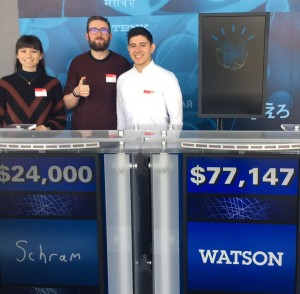IBM Watson
How YOOX NET-A-PORTER GROUP Used Watson to Bring Consumers Celebrity Style
March 21, 2017 | Written by: Team Schram
Categorized: IBM Watson
Share this post:
When our YOOX NET-A-PORTER GROUP team took part in a recent Watson Hackathon, we sought to answer an age-old fashion question: what is she wearing? Fashion followers always want to know where they can get the latest pieces to create the outfits they see and like. This curiosity is truer today than ever before since consumers now shop in micro-moments – scouring images for trend ideas, finding the best quality products, and then buying with a touch on their phone or a mouse click.
 We want to give shoppers the ultimate experience on our website. As a luxury fashion business, our aim is to create the best personalized shopping experience for the customer. Since influencer and celebrity style, particularly through social media, largely impacts shoppers’ preferences, we wanted to incorporate celebrity fashion ensembles on the homepage.
We want to give shoppers the ultimate experience on our website. As a luxury fashion business, our aim is to create the best personalized shopping experience for the customer. Since influencer and celebrity style, particularly through social media, largely impacts shoppers’ preferences, we wanted to incorporate celebrity fashion ensembles on the homepage.
So last month when our CIO, Alex Alexander, put together our second global hackathon – the first YOOX NET-A-PORTER GROUP hackathon focused on using IBM Watson – we chose to apply cognitive computing to make the fashion styles of celebrities more accessible to their fans. We wanted to build a product using Watson that could recommend products based on photos of fashion influencers sourced from popular blogs and Instagram feeds. We aimed to give customers the immediate satisfaction of see-now-buy-now by putting direct links to products on the homepage.

YNAP Developers (L-R): Sydney Smith, Chris Gregori, and Sam Lake (aka, Team Schram).
We used Watson’s Visual Recognition API, a service on IBM Bluemix hosted on IBM Cloud, to create image classifiers based off our existing product categories, and then trained the new tool using existing product images from our catalogue.
In other words, when we gave an image to the Visual Recognition service, it could tell us key information about the products featured – such as color, main product category, and sub product category.
Once we completed the back-end of the prototype, we built a front-end component that could be deployed onto the NET-A-PORTER homepage. We provided examples of how to use the service based on images of on-brand influencers, and also provided users a way of inputting their own images. The Visual Recognition service analyzed the images and provided links to visually similar products.
In just 36 hours, we built a convincing AI personal shopping concierge that could provide suggestions and aid creatives when they are curating fashionable looks from large product catalogues. If Watson Visual Recognition is trained overtime with more images and product information, this digital shopping assistant, could also help personal shoppers and YNAP customers buy the celeb styles they adore with just a tap.

YNAP's: Sydney Smith, Graduate Product Owner; Chris Gregori, Developer; Sam Lake, Developer
Making the workplace safe for employees living with HIV
The recent promising news about Covid-19 vaccines is in sharp contrast to the absence of a vaccine for HIV, despite decades of research. Unlike Covid-19 with a single viral isolate that shows minimal diversity, HIV circulates in a wide range of strains that so far have proven impervious to a single vaccine. Fortunately, more people […]
Call for Code for Racial Justice Needs You: Join the Movement
IBM has never avoided taking on big challenges. At IBM, we are privileged to drive impact at scale. We take on challenges that transform our clients, impact people’s lives and innovate for future generations as we strive to effect systematic societal change. Over the course of our 109-year history, the evidence has become clear that […]
A New Wave: Transforming Our Understanding of Ocean Health
Humans have been plying the seas throughout history. But it wasn’t until the late 19th century that we began to truly study the ocean itself. An expedition in 1872 to 1876, by the Challenger, a converted Royal Navy gunship, traveled nearly 70,000 nautical miles and catalogued over 4,000 previously unknown species, building the foundations for modern […]


